Details to Use in Describing Characters
Kaitlyn Dunnett/Kathy Lynn Emerson here, writing today about the challenges of finding just the right descriptive details to make characters, even the minor ones, distinctive for the reader. Although it is possible to write about someone without ever describing their appearance, in most cases it helps to provide a few hints. If the reader first meets a character in Chapter Two and he doesn’t appear again until Chapter Nine, it is convenient to be able to refer to “the guy with the big nose” or “the woman with the squeaky voice” to refresh the reader’s memory, rather than rehash the entire earlier encounter.
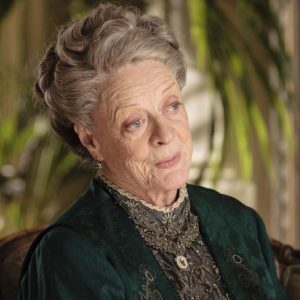
one of the great British faces
You can, of course, model a character’s physical appearance on a real person. There are some great faces out there, especially among British actors. And, at least in a contemporary setting, you can describe someone as looking like a young Judi Dench or an older version of Miley Cyrus. There are a couple of problems with that, though. You need to be certain that your readers know who the heck you’re talking about. And, of course, the reference may end up dating your work.
A better plan is to come up with a few memorable details to describe each new character as he or she comes into the story. The difficulty comes in finding a happy medium between details that are bland—he was six feet tall with brown hair and blue eyes and an aquiline nose—and language that is way too florid. Some of the best (or worst) examples of the latter are finalists in the annual Bulwer-Litton competition for opening lines. That said, the boundary between an over-the-top description and writing that is vivid can often be a bit blurry, and it is very easy to get stuck trying to come up with the right words to describe someone, no matter how clear the writers’ mental picture of the character may be.
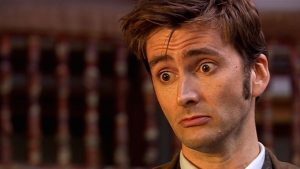 Not too long ago, the Maine Romance Writers’ Facebook page posted a link to a “Master List of Facial Expressions for Writers!” Naturally, this intrigued me, so I followed the link to Bryn Donovan’s webpage. It turns out that Bryn has written an entire book, Master Lists for Writers, and published excerpts online to give folks a feel for what’s in it. I have not read the book, or all of the online lists, but what I did look at is exactly the sort of thing that writers trying to describe a new character would find useful.
Not too long ago, the Maine Romance Writers’ Facebook page posted a link to a “Master List of Facial Expressions for Writers!” Naturally, this intrigued me, so I followed the link to Bryn Donovan’s webpage. It turns out that Bryn has written an entire book, Master Lists for Writers, and published excerpts online to give folks a feel for what’s in it. I have not read the book, or all of the online lists, but what I did look at is exactly the sort of thing that writers trying to describe a new character would find useful.
What all this is leading up to is a similar share from me. Over the years, while writing both historical and contemporary novels, I came up with my own “Details to use in Describing Characters” list, arranged by an assortment of somewhat random categories. I refer to this collection of descriptive details every time I start a new book. It has saved me many a frustrating stretch of searching for just the right word. Feel free to borrow at will.
attitude:
meek
always listening
slovenly

a great exercise is to find the words to describe this famous character
build:
gangly
narrow shoulders
all angles
beanpole thin
newly-acquired height
wiry
flabby
stolid
sinewy
thin-chested
fine-boned
dainty
bulging biceps
corpulent
spindly legs
slightly bow-legged
plump ankles
dewlaps
angular
gaunt
scarecrow
rawboned
stoop-shouldered
fleshy
slight paunch

here’s another, if you don’t get distracted by the cat
slightly concave abdomen
lean
heavy-set
complexion:
pallid
florid
lost looks to swine pox (from the 16th century novels, obviously)
ruddy
splotchy
sallow
full of pustules and a new quat (ditto)
pale, flawless skin
livid scar
swarthy
peaches and cream
dusky
ears:
oversized
protuberant
hard of hearing
 eyes:
eyes:
mild gray
shortsighted
faded blue
perpetual squint
gimlet
almond-shaped
wide-spaced
murky green
pale, watery
protuberant
trough-eyed (one lower than the other)
brown so dark they appear black
squint-eyed
deep bags under—look of a sorrowful hound
heavy-lidded
molasses-colored
color of hazelnut shells
lynx-eyed (sharp sighted)
mud colored
beady little
wears an eye patch
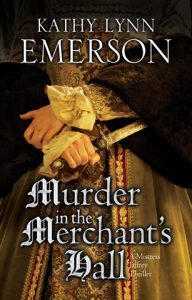
publisher’s way to avoid showing sleuth’s face
face and facial hair:
negligible chin
broad red beard
moonfaced
horse-faced
double chins
bushy eyebrows
broad forehead
jowly
sculpted features
plump cheeks
high cheekbones
trailing mustache
wispy beard
long beard, narrowing toward chin
hollow cheeks
little tuft of a beard
cleft in chin
freckles
winged eyebrows
pockmarked
red-cheeked
narrow jaw
mole on one cheek
fleshy
fingers:
long
plump
steepled
thick as sausages
gait:
walked flat-footedly with a shuffling movement
awkward
lack of grace
slight limp
rolling
slow-moving
hobbles
scuttles
shambling
light on the feet
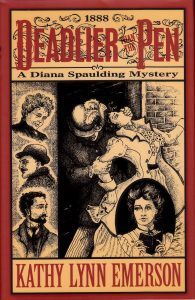
cover art with lots of descriptive detail
hair:
straw-colored
the color of ___
bald
mud-colored
lank
receding hairline
rich, blue-black hair that reflects sunlight
sand-colored
thinning
ginger
hands:
hamlike
meaty
folded over slightly concave abdomen
laugh:
trilling
rusty
mouth and teeth:
lips flattened in a hard line
thin, cruel
large yellow teeth
toothless
four large front teeth all the same size
pouting lips
small, perfect
missing tooth in front
blue-tinged lips
brown teeth
teeth overlap
toothy smile
small, sexy gap between two front teeth
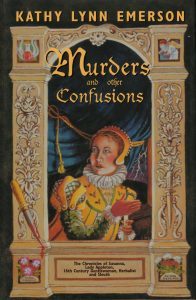
Is a picture worth a thousand words? Is this Lady Appleton from my Face Down and Mistress Jaffrey mysteries?
nervous habits:
fidgets
tugs on beard
drums fingers on ___
clenches and unclenches hands
pleats fabric
nose:
hawklike
broken veins in
bulbous
beak of a
bump on the bridge from a break
large, slightly flattened
Roman
aquiline

or is this Lady Appleton? (same artist, by the way, the talented Linda Weatherly S.
smell:
musky perfume
scent of lavender
old socks
scented kitty litter
voice and diction:
soft-spoken
nasal whine
sniffles
sultry
slow, measured speech
repeats everything twice
hoarse smoker’s
raspy
deep baritone
clipped speech
lazy drawl
careful of words
And there you have it. Kathy/Kaitlyn’s little list. They may all be things you’d think of anyway, but sometimes having a quick reference written down can be a life saver. Happy Writing, Everyone!

Kathy Lynn Emerson/Kaitlyn Dunnett is the author of over fifty books written under several names. She won the Agatha Award for best mystery nonfiction of 2008 for How to Write Killer Historical Mysteries and was an Agatha Award finalist in 2015 in the best mystery short story category for “The Blessing Witch.” Currently she writes the contemporary Liss MacCrimmon Mysteries (Kilt at the Highland Games) as Kaitlyn and the historical Mistress Jaffrey Mysteries (Murder in a Cornish Alehouse ~ UK in December 2016; US in April 2017) as Kathy. The latter series is a spin-off from her earlier “Face Down” series and is set in Elizabethan England. Her websites are www.KaitlynDunnett.com and www.KathyLynnEmerson.com



